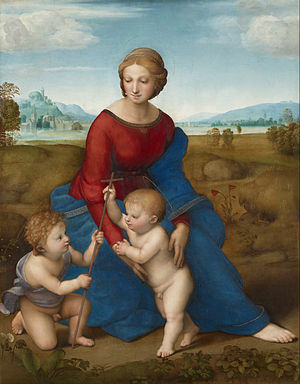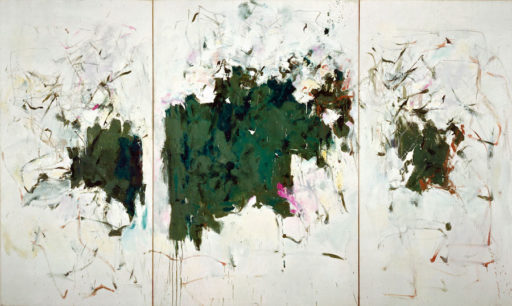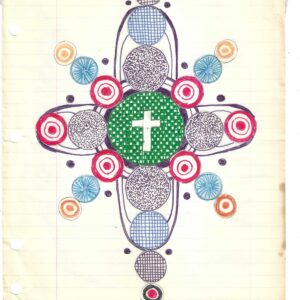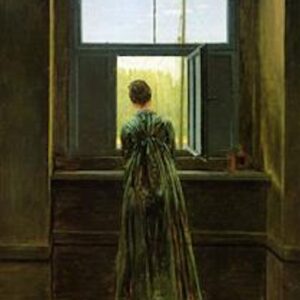I don’t know if you can call it a religious painting. Probably you can’t. That’s to say, there is no explicit religious intent in the painting as far as I’m aware, and certainly no one looking at the painting is going to suddenly pick out Moses or anything. It is a painting of a few blobs of black and green and a few other colors that sort of zingle through the canvas here and there.
So, it’s not a religious painting. Of course, you could very well object that we haven’t set forth a working definition of what makes a painting a religious painting, and so it is going to be hard to decide what paintings are religious and what paintings aren’t. But it can’t just be subject matter, can it? I mean, look at something like the Madonna del Pratoby Raphael. That’s a pretty good painting, all in all. The big blueness of Mary’s cloak or whatever it is, is especially pleasing. There’s some kind of pooling happening with that blue, and then Mary’s nice perchy head is emerging out of that pooling blue and you just can’t not admire the, I don’t know, I want to call it the structured quality of that little scene by Raphael. Yes, I think of it as a sculpted painting, if you know what I mean.

But let us be honest, there is really nothing religious about this painting by Raphael. Sure, there is Mary and baby Jesus and baby John the Baptist. Okay, I will give you that. Technically, it is a religious painting if you want to be lawyerly about it. But I don’t want to call it a religious painting, even though I’m damned if I can give you any working definition of what makes a painting religious.
I should have said at the outset that what I’m really talking about is Girolata Triptych by Joan Mitchell. That’s the painting with the blobs of black and green and a few zings. Actually, the painting is a sort of landscape or seascape. Sort of. It depicts, but only vaguely depicts, a bit of coastline on the western side of Corsica. Joan Mitchell was lollygagging about that area in the early 1960s. And she painted the painting after, I don’t know, especially liking that spot during her travels and then painting about it later in her studio. She saw something, experienced something there, that day.
So we’ve got Raphael’s Madonna del Prato on one side and Mitchell’s Girolata Triptych on the other. The first was made explicitly to be a religious picture and the second it would almost be crazy to call a religious picture. It has nothing to do with religion. Only, I think it does have to do with religion, though I can’t prove it since such a thing can’t be proven and probably no one is going to be persuaded by me anyway and surely the real fact of the matter is that no one cares, no one gives a single shit about my non-definition of what makes a painting religious.
But here’s one thing I want to say. You can’t just paint Christ as, say, a nice looking guy with a well-trimmed beard or a fat baby or a sad fellow on the tree or any of that. I mean, you can. No one will stop you. But you can’t. I don’t want you to.
What I want you to do instead is to paint three panels just like Joan Mitchell did. Notice, mind you, that if you squint your eyes in front of Girolata Triptych you might be fooled into thinking that opening up your eyes again will reveal some medieval crucifixion scene. That’s what is so funny about Girolata Triptych. In its basic structure it is like any number of medieval crucifixion scenes. Basically, the trick in making a crucifixion scene is you put the main focus in the middle section, that’s Christ on his Cross, and then put some other figures off to both sides. Three points of focus with the central one somewhere toward the middle. That’s it. Done.
And that’s exactly what Joan Mitchell did in Girolata Triptych. So it is a religious painting after all. Except of course that she was painting a landscape/seascape. And even the landscape/seascape is really nothing more than the bare suggestion of a scene. Maybe the picture is just paint on a surface and nothing more. But no, it can’t be that. Because of the structure of it and the hazy sense of background and foreground, all the sorts of little cues that a painting gives you when the painting says there is something here, there is something that made this painting happen, this painting is structured the way that a visual memory is structured, and this painting is carefully constructed, actually, even in its abstraction, and in its blobby-at-first-glance-unformed appearance it is actually the rigorous attempt to get something right about how a certain moment of being-there, of being-in-the-world at a specific time and place and the way one felt and the way the sun warmed one’s face on that one day in the Mediterranean and the way that a certain hazy sensibility came into one’s soul because the rocks and the coast and the sea looked and felt just so. This is what Girolata Triptych is rigorously producing and making manifest on the canvas. It is the rigorous making present of something, an experience, a being-in-the-world that is anything but rigorous. It is the absolute fidelity toward that which actually cannot be shown or expressed or conveyed. It is the perfect exposition of what can only be a failure.
Absolute and total being-a-specific-sort-of-being-there-creature-at-a-temporal-moment-in-the-flashing-past-of-an-encounter-with-other-being-there-structures-and-things. That’s how I’d describe Girolata Triptych if I had to do it. It is a crummy mouthful, I know. But that’s what I’d want a crucifixion scene to be as well. I’d want it to give me a sense of Christ as that flashing-into-presence, that guy who somehow knew, intuitively, that the way to be eternal is to be utterly finite. That’s what the death of Christ is, isn’t it? The absolutely-beyond-all-temporality and the completely-and-without-remainder-finite flashing together suddenly in a moment that both shakes and establishes the foundations of the world? How do you paint that? How do you paint the fact that God, the face of God, is in fact the face of a dumb loser whose only true legacy is failure and ignominious death? How do you paint the fact that The Truth is small and sad and pathetic and a little bit funny and beautiful beyond expressing? Personally, I’d start with a blob of black and the darkest green and a little gaudy swizzle of pink in one goofy heartbreaking spot within the impenetrable darkness. That’d be a good place, at least, to start.
Morgan Meis has a PhD in Philosophy and is a founding member of Flux Factory, an arts collective in New York. He has written for n+1, The Believer, Harper’s Magazine, The Virginia Quarterly Review and is a contributor at The New Yorker. He won the Whiting Award for non-fiction in 2013. Morgan is also an editor at 3 Quarks Daily, and a winner of a Creative Capital | Warhol Foundation Arts Writers grant. A book of Morgan’s selected essays can be found here. His new book from Slant is The Drunken Silenus. He can be reached at morganmeis@gmail.com.





